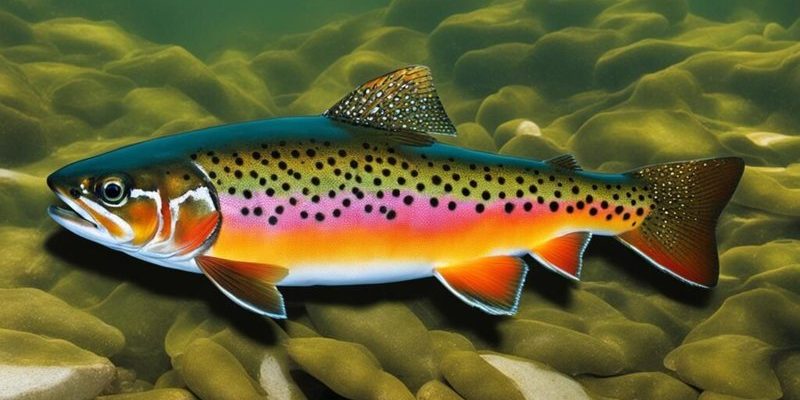![Trout Vs. [Similar Species] - Key Differences](https://gudri.com/wp-content/uploads/2025/06/Trout_Vs___Similar_Species______Key_Differences_image_0.jpg)
In this article, we’re diving deep into the key differences between trout and salmon. We’ll explore their habitats, physical characteristics, feeding habits, and even their roles in fishing and cooking. Whether you’re a seasoned fisherman, a cooking enthusiast, or just someone who’s curious, this guide will help you appreciate what makes each of these fish special.
Habitat: Where They Swim
Understanding the habitat of trout and salmon is essential to grasping their differences. Trout are often found in cold, clear streams and rivers, thriving in fresh, oxygen-rich waters. They love to hang out in rocky areas, where they can find shelter and food. You might picture them darting around in the ripples of a mountain stream, searching for insects and small fish.
On the other hand, salmon have a more versatile habitat. They are born in freshwater streams but spend much of their adult life in the ocean. After a few years, they return to their birthplace to spawn. This remarkable migration can cover hundreds, even thousands, of miles. Imagine a salmon navigating its way back home, overcoming obstacles like waterfalls and strong currents. It’s a journey that truly highlights their determination!
Physical Differences: Spot the Difference
When it comes to looks, both trout and salmon are stunning in their own right, but they have some noticeable differences. Trout typically have a more rounded body with a shorter head. They’re known for their vibrant colors, with patterns of spots that can vary from species to species. For instance, the rainbow trout has those iconic rosy stripes that make it a favorite among fishers and photographers alike.
Salmon, in contrast, are generally more streamlined and have a more elongated shape. Their coloration often changes depending on their life stage. Freshwater salmon can be silvery, whereas spawning salmon take on darker hues. Their bodies don’t have the same spot patterns as trout, which gives them a sleeker appearance. So, next time you’re near a lake or river, take a moment to observe these fish closely—they’re quite different!
Feeding Habits: What’s on the Menu?
Feeding habits are another area where trout and salmon diverge. Trout are opportunistic feeders. They’ll munch on whatever they can find, including insects, crustaceans, and smaller fish. This adaptable diet makes them great for growing in a variety of habitats. You might even find them flipping over stones in search of tasty treats.
Salmon have a more focused diet, especially as they transition to life in the ocean. They primarily feed on smaller fish, such as herring and anchovies, and rely heavily on plankton in their early stages. This difference in diet not only shapes their growth but also influences the flavor of their meat. Many chefs rave about the rich, buttery taste of salmon thanks to its diet, while trout offers a milder, more delicate flavor.
Angling Techniques: How to Catch Them
If you’re planning to fish for either trout or salmon, knowing the right techniques can make all the difference. When it comes to trout, anglers often use lightweight gear and lures that mimic their natural food sources. Many prefer fly fishing, which allows for a delicate presentation that entices these curious fish. Picture yourself casting a tiny fly just above the water’s surface—that’s often where the magic happens!
Salmon fishing, on the other hand, can require heavier gear due to their size and strength. Anglers might use trolling techniques or heavier lures designed to withstand the powerful runs of a salmon. It’s not uncommon to hear stories of salmon fights that leave anglers breathless as they reel in their catch. Whether you’re after a trout or salmon, both adventures offer excitement, but they definitely call for different strategies.
Culinary Uses: From River to Table
When it comes to the dinner plate, both trout and salmon shine in their own ways. Trout is often prepared grilled, baked, or pan-fried, and its mild flavor pairs well with a variety of seasonings. A squeeze of lemon and some fresh herbs can really elevate a trout dish. It’s a go-to for many home cooks who appreciate a quick and delicious meal.
Salmon, known for its rich taste and texture, is often the star of the show at dinner parties. It can be prepared in numerous ways, from smoking to poaching, and it holds up beautifully to bold flavors. Think cedar plank salmon or a zesty teriyaki glaze! With its health benefits and omega-3 fatty acids, salmon is a powerhouse of nutrition, making it a popular choice for both casual meals and special occasions.
Conservation: Protecting Our Fish
Finally, let’s talk about conservation efforts surrounding these two fish. Trout and salmon populations face challenges due to habitat loss, pollution, and overfishing. Many organizations are working hard to preserve their habitats and promote sustainable fishing practices. If you enjoy fishing or simply appreciate these beautiful fish, consider supporting local conservation efforts.
By making a conscious effort to protect these species, we help ensure that future generations can fish and enjoy the natural beauty of our rivers and lakes. Plus, knowing that you’re contributing to the well-being of our environment can make your fishing (or dining) experience even more rewarding.
In the end, while trout and salmon may share some similarities, their differences are what make them fascinating. From their habitats and physical traits to their feeding habits and culinary uses, each fish has its own story to tell. Whether you’re casting a line or preparing a meal, understanding these differences enhances our appreciation for both trout and salmon. So, the next time you find yourself by the water or in the kitchen, think back to what you’ve learned here. There’s so much more to these fish than meets the eye!

